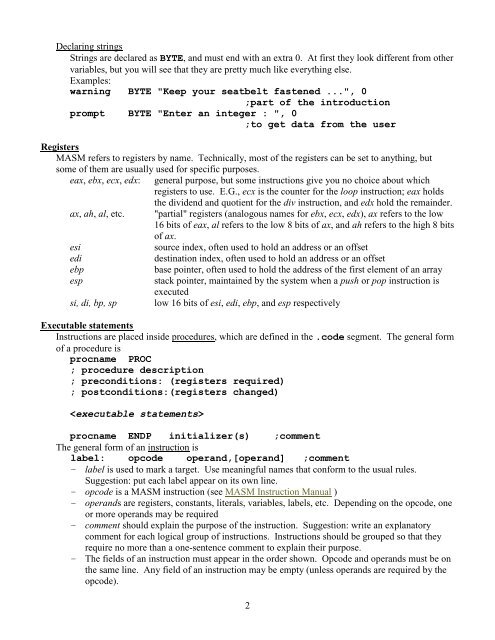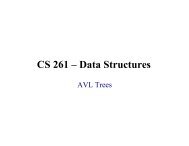Guide to MASM Programming - Classes
Guide to MASM Programming - Classes
Guide to MASM Programming - Classes
Create successful ePaper yourself
Turn your PDF publications into a flip-book with our unique Google optimized e-Paper software.
Declaring strings<br />
Strings are declared as BYTE, and must end with an extra 0. At first they look different from other<br />
variables, but you will see that they are pretty much like everything else.<br />
Examples:<br />
warning BYTE "Keep your seatbelt fastened ...", 0<br />
;part of the introduction<br />
prompt BYTE "Enter an integer : ", 0<br />
;<strong>to</strong> get data from the user<br />
Registers<br />
<strong>MASM</strong> refers <strong>to</strong> registers by name. Technically, most of the registers can be set <strong>to</strong> anything, but<br />
some of them are usually used for specific purposes.<br />
eax, ebx, ecx, edx: general purpose, but some instructions give you no choice about which<br />
registers <strong>to</strong> use. E.G., ecx is the counter for the loop instruction; eax holds<br />
the dividend and quotient for the div instruction, and edx hold the remainder.<br />
ax, ah, al, etc. "partial" registers (analogous names for ebx, ecx, edx), ax refers <strong>to</strong> the low<br />
16 bits of eax, al refers <strong>to</strong> the low 8 bits of ax, and ah refers <strong>to</strong> the high 8 bits<br />
of ax.<br />
esi<br />
source index, often used <strong>to</strong> hold an address or an offset<br />
edi<br />
destination index, often used <strong>to</strong> hold an address or an offset<br />
ebp<br />
base pointer, often used <strong>to</strong> hold the address of the first element of an array<br />
esp<br />
stack pointer, maintained by the system when a push or pop instruction is<br />
executed<br />
si, di, bp, sp low 16 bits of esi, edi, ebp, and esp respectively<br />
Executable statements<br />
Instructions are placed inside procedures, which are defined in the .code segment. The general form<br />
of a procedure is<br />
procname PROC<br />
; procedure description<br />
; preconditions: (registers required)<br />
; postconditions:(registers changed)<br />
<br />
procname ENDP initializer(s) ;comment<br />
The general form of an instruction is<br />
label: opcode operand,[operand] ;comment<br />
– label is used <strong>to</strong> mark a target. Use meaningful names that conform <strong>to</strong> the usual rules.<br />
Suggestion: put each label appear on its own line.<br />
– opcode is a <strong>MASM</strong> instruction (see <strong>MASM</strong> Instruction Manual )<br />
– operands are registers, constants, literals, variables, labels, etc. Depending on the opcode, one<br />
or more operands may be required<br />
– comment should explain the purpose of the instruction. Suggestion: write an explana<strong>to</strong>ry<br />
comment for each logical group of instructions. Instructions should be grouped so that they<br />
require no more than a one-sentence comment <strong>to</strong> explain their purpose.<br />
– The fields of an instruction must appear in the order shown. Opcode and operands must be on<br />
the same line. Any field of an instruction may be empty (unless operands are required by the<br />
opcode).<br />
2

















